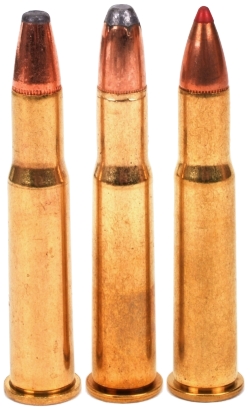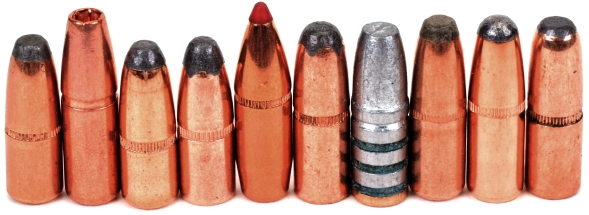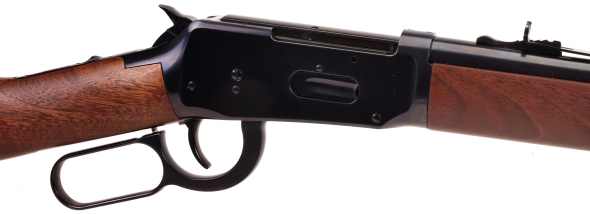
These days, some folks seem to have fun referring to the 30-30 Winchester cartridge by its original name, the 30 Winchester, or the 30 WCF, or the 30 Winchester Smokeless. Not unlike the .45 Colt Vs Long Colt fiasco or using or not using the leading decimal point in a caliber designation that refers to bore rather than groove diameter. But then, without these meaningful debates, Internet firearm forums would have little participation.
The 30-30 Winchester is not a hot rod and it is quite uncooperative when attempts are made to boost its bowling ball like velocity. Its case lacks sufficient powder capacity to generate the required gas persistence behind a 0.308″ bullet to achieve higher velocities. Using faster powder, and pumping up pressure above SAAMI maximum, isn’t a thinking man’s solution as a typical lever action rifle is designed to stay in one piece only when subjected to moderate pressure levels.
A handload that falls within SAAMI pressure limits of 42,000 psi can push a 150 grain bullet to approximately 2300 fps with 1782 ft/lbs of muzzle energy, when fired from a 20′ barrel lever action rifle. Changing to a beefy universal receiver and 20″ test barrel, and running up the pressure to 60,000 psi, adds approximately 190 fps with a load that would surely pepper a landscape with spontaneously disassembled lever action parts.
Why choose the 30-30 Winchester over something akin to 338 Winchester Mag for hunting anything larger than a jackrabbit? Hunting deer, hogs, black bear or any other game of similar size at distances inside 150 yards, a lever action 30-30 Winchester offers: appropriate killing power, light weight, fast handling, low recoil, low report, and inexpensive ammunition. Why do some folks elect to hunt jackrabbits with a 338 Winchester Mag? Why do some people choose to be rodeo clowns?
The 30-30 WCF in factory form is so well behaved and offers such predictable performance, one might think of it as the mensch of centerfire rifle cartridges. So why bother handloading the round? It’s the bullets…man. The cartridge is flexible enough for use in many hunting applications, from very thin shinned game to heavier boned, tough muscled game. Unfortunately, most ammunition manufacturers offer only a choice of 150 or 170 grain bullets, round or flat nose, lead core soft points, making it difficult to calibrate factory ammo to specific game and circumstances.
In 1980, while sitting down and taking a break, 50 yards out a large hog wandered into my uphill field of view. My shot hit low in the chest, blew out its heart and left a 2″ exit wound high and behind the opposite shoulder. The pig expired where it stood. A year later, a pig again wandered into my field of view, in roughly the same circumstances, but this time the shot resulted in the pig showing me its butt and running 200 yards before collapsing as pile of adrenaline ladened pork chops. Both 150 gain bullets, both fatal, one tore up a lot of meat, one did not kill cleanly.
Handloading the 30-30 WCF provides the flexibility of matching bullets with game and hunting circumstances. More quickly expanding bullet types for deer and hogs, cast or heavy jacketed Swift A Frame or Nosler Partitions for black bear and even moose or elk within the cartridge’s range. Solid copper bullets can be used when hunting in states under communist control.
Yes, there are 12 brands of 30-30 Winchester ammo, produced in 34 load variations. However, close examination suggests these share 4 common bullet types. There are 35 distinctly different bullet types and weights available from over a dozen manufactures available to 30-30 Winchester handloaders and it is still possible to load a 29 count box of high grade 30-30 Winchester cartridges, with premium bullets, for under $10.
The 30-30 WCF has lousy accuracy… Does not! Does too!
 After many years of shooting the 30-30 WCF cartridge, from single shot handguns and lever, pump, break action, and bolt action rifles, I’ve come to the conclusion that the 30-30 WCF is definitely one of the two; accurate or inaccurate. Perhaps more than some other cartridges, the 30-30 Winchester accuracy is fairly sensitive to bullet size and shape changes, as well as barrel length and twist rate variations. No, I don’t really no why as it usually takes high velocity and associated high bullet rotational speeds to bring out the flaws in bullets and rifles.
After many years of shooting the 30-30 WCF cartridge, from single shot handguns and lever, pump, break action, and bolt action rifles, I’ve come to the conclusion that the 30-30 WCF is definitely one of the two; accurate or inaccurate. Perhaps more than some other cartridges, the 30-30 Winchester accuracy is fairly sensitive to bullet size and shape changes, as well as barrel length and twist rate variations. No, I don’t really no why as it usually takes high velocity and associated high bullet rotational speeds to bring out the flaws in bullets and rifles.
Most recently, while running a substantial number of rounds down the bore of a very nice some Winchester Model 94 some things became apparent. The specific ammo was 150 grain Federal Fusion, 160 grain Hornady LeverEvolution and 150 grain Winchester Super X.
The Winchester had the shortest bullet length and most orbiculate nose within the group. Sort of like me in high school. The Federal bullet was longer with a sharply tapered but truncated ogive and the Hornady bullet was exceptionally long with a sharply pointed, but tubular magazine safe, tip.
At 100 yards, 3 shot groups ran 2 1/8″, 1 5/8″ and 3/4″ respectively. Two more sets of groups were shot, all resulting in essentially the same which, of course, confirmed my earlier conclusion that the 30-30 WCF can be accurate or inaccurate, depending on what type of ammo it is fed. In the case of the Winchester Model 94, the rifling is a bit… casual with a 1:12″ twist, it seemed handloading might be the way to extract that varmint rifle like accuracy with a wider range of bullet types.
Tryouts for the majors
Ten bullets produced specifically for the 30-30 Winchester were selected; solid, lead core, some long, some short, all with a locating cannelure. The brass utilized was all once fired Remington, primer type was CCI 200 and a selection of powder of varying burn rate to assure case full loads.

Data is listed on the table below, top to bottom, as they appear above, left to right.
 |
Warning: Bullet selections are specific, and loads are not valid with substitutions of different bullets of the same weight. Variations in bullet material and length will alter net case capacity, pressure and velocity results. Primer selection is specific and primer types are not interchangeable. These data represents maximum loads in our firearms and test equipment and may easily be excessive in other applications. All loads should be reduced by 3%, and developed following safe handloading practices as represented in established reloading manuals produced by component manufacturers. Presentation of these loads does not constitute a solicitation for their use, nor a recommendation.
|
||||||||||||||||||||||||||||||||||||||||||||||||||||||||||||||||||||||||||||||||||||||||||||||||||||||||||||||||||||||||||||||||||||||||||||||||||||||||||||||||||||||||||||||||||||||||||||||||||||||||||||||||||||||||||||||||||||||||||||||||||||||||||||||||||||
|
|||||||||||||||||||||||||||||||||||||||||||||||||||||||||||||||||||||||||||||||||||||||||||||||||||||||||||||||||||||||||||||||||||||||||||||||||||||||||||||||||||||||||||||||||||||||||||||||||||||||||||||||||||||||||||||||||||||||||||||||||||||||||||||||||||||
Comments… You know, like on Facebook, but on topic
While a great deal of time is typically wasted in experimenting with bullet seating depth and COL, all of the pictured bullets were seated to roll crimp at the cannelure. Not so much for handloading finesse as much as it stops a round from tippy tapping a trailing round’s bullet into its neck.
I did go all renegade on the 150 grain Remington Core-Lokt powder selection by using Norma 201 because… I almost never use it for anything else. In my defense… Nope, there is no defense. Substitutes are IMR 3031 33.5 grains @ 2379 fps or RamShot Big Game 38.0 grains @ 2347 fps. I would have suggested Win 748 35.5 grains @ 2360 fps, but that seemed to predictable.
There are two Hornady 0.308″ 160 grain FTX bullets, the 30395 for the 30-30 WCF and the 30396 for the 308 Marlin Express. Slightly different profiles, same B.C., but the cannelures are in significantly different location… like Texas and Oregon, making them not interchangeable. The Hornady FTX isn’t much of a barrel burner, to say the least, but it might make up for the modest muzzle velocity by applying its slicker ballistic coefficient to improved down range performance. Let’s take a look at the Real Guns Ballistics Calculator results…
| Hornady 160 Grain FTX Bullet | |||||||
| Yards | 0 | 50 | 100 | 150 | 200 | 250 | 300 |
| Velocity – fps | 2268 | 2146 | 2028 | 1914 | 1804 | 1697 | 1596 |
| Energy – ft.-lbs. | 1827 | 1636 | 1461 | 1301 | 1155 | 1023 | 905 |
| Momentum – lbs-sec | 1.61 | 1.52 | 1.44 | 1.35 | 1.28 | 1.20 | 1.13 |
| Path – in. | -1.5 | 1.7 | 3.0 | 2.2 | -1.0 | -6.9 | -15.8 |
| Drift – in. | 0.0 | 0.0 | 0.0 | 0.0 | 0.0 | 0.0 | 0.0 |
| Time of flight – sec. | 0.0 | 0.1 | 0.1 | 0.2 | 0.3 | 0.4 | 0.5 |
| Best Zero Results | |||
| Near-Zero – Yards | 20 | Midrange – Yards | 106 |
| Far-Zero – Yards | 188 | Max Ordinate “ | +3.0 |
| Point-Blank – Yards | 220 | ||
Even though the Hornady launches 107 fps slower than the Winchester 150 grain Power Point Flat Nose, the Hornady’s 0.330 B.C. has it moving faster, retaining more energy with the same trajectory as the Winchester 150 grain Power Point with its 0.222 B.C.. Point blank range pick up with the Hornady is only 4 yards, but at 300 it drops 2″ less and is pulling nearly 50% more ft/lbs of energy; 905 ft/lbs of energy is more than enough for deer size game at that range where the Winchester’s 660 ft/lbs would be a bit of a stretch, and the Hornady’s 16″ of drop at that range is manageable.
| Winchester 150 grain Power Point | |||||||
| Yards | 0 | 50 | 100 | 150 | 200 | 250 | 300 |
| Velocity – fps | 2375 | 2190 | 2014 | 1846 | 1687 | 1541 | 1408 |
| Energy – ft.-lbs. | 1878 | 1597 | 1350 | 1135 | 948 | 790 | 660 |
| Momentum – lbs-sec | 1.58 | 1.45 | 1.34 | 1.23 | 1.12 | 1.02 | 0.93 |
| Path – in. | -1.5 | 1.6 | 3.0 | 2.1 | -1.2 | -7.7 | -17.8 |
| Drift – in. | 0.0 | 0.0 | 0.0 | 0.0 | 0.0 | 0.0 | 0.0 |
| Time of flight – sec. | 0.0 | 0.1 | 0.1 | 0.2 | 0.3 | 0.4 | 0.5 |
| Best Zero Results | |||
| Near-Zero – Yards | 21 | Midrange – Yards | 107 |
| Far-Zero – Yards | 186 | Max Ordinate “ | +3.0 |
| Point-Blank – Yards | 216 | ||
For the most part, bullets with weight shifted away from the shank end and loaded in a more rounded ogive held the best accuracy. That said, all of the loads listed are good enough for minute of a deer performance, especially at the ranges they would be used. The Hornady on a straight projection would group 4″ – 4.5″ at 300 yards, but I would not be surprised if it didn’t tighten a bit over the long haul. I don’t know, I did not shoot 300 yard groups.
A little William Shatner and a little Chris Pine
The Winchester Model 94 changed because it was required to do so; legislative pressure, improved materials and production methods, a changing market place and strategy. For the most part, the changes have had a positive influence on the Model 94’s function and performance. The cartridge is easy and rewarding to handloads and handloading this round can save a hunter a few bucks… no, not the kind with antlers.

Is the Model 94 a viable deer rifle? I have to say of course, from first hand experience this combination is more than enough and I have no need to create a new theory to pretend I have some unique insight. The 30-30 WCF has been an effective deer slayer for over 100 years, tree and shrubs leave many eastern hunters shooting close in and deer have not gotten any tougher or more… bullet resistant over the past century.
Is there something I would change? You bet. I would lose the rebounding hammer and leave the tang safety, but I am afraid the days for that possibility are gone. I would love to see a 1:10″ twist rather than a 1:12″ simply because there are so many solid copper bullets popping up to serve hunters in dim bulb states where lead core bullets are being politically legislated out of use. That’s it. The 30-30 WCF cartridge has stood the test of time and passed with flying colors. The Winchester Model 94 is well built, built to last, good looking and good shooting. Is there anything more required?
Winchester’s Model 94 Short Rifle Part 1
Winchester’s Model 94 Short Rifle Part 2

Email Notification